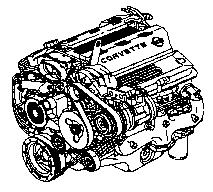 |

Select Image to Enlarge |
 |

Select Image to Enlarge |
Some of the engine parts can be interchanged with the earlier small
block. Among these are the camshaft (92-94 only), the 95 cam has a steel pin
which drives the water pump instead of the 92-93 gear drive. The pistons, piston
rods, oil pump, crankcase, valve covers, exhaust manifolds, rear oil seal,
flywheel and valve train components are interchangeable. The block, heads,
timing cover, water pump, timing gears and intake manifolds are not. Accessory
mountings such as power steering pump, alternator, AC compressor and harmonic
balancer cannot be interchanged. The A.I.R. compressor for emissions is now an
electric air pump. The harmonic balancer is a two piece assembly and is the same
on the Camaro, Pontiac, Caprice, but different on the Corvette.
There are also some differences between engines in the Corvette, F Body cars, and the Caprice. The Corvette has 4 bolt mains and cast pushrod guides in the aluminum heads. The F Body cars and Caprice have 2 bolt mains. The F Body cars have aluminum heads and the Caprice has cast iron heads.
As you can see the engines, while similar, are quite different than the original SB V8. If you are planning to install a LT1 engine in an earlier model Chevrolet you will find that it will bolt into place with the same engine mounting and that it will also bolt up to any transmission built for a small block V8. Be prepared to change all accessory mounts and accessories ie., AC compressor, alternator, power steering pump, related pulleys and belt tensioning components.
1994 LT1
In 1994 GM introduced sequential port injection for the small block V8. While the engine is essentially the same, GM replaced the "plug in" EPROM "CHIP" with Electrically Eraseable Programmable Read Only Memory (EEPROM). You can no longer install a performance chip in these computers which are now referred to as Powertrain Control Modules or (PCM). These PCM's also electronically control the transmission in addition to engine fuel management functions. The Mass Air Flow Sensor is back in 94. The LT1 also has a MAP sensor. This setup should enhance engine performance significantly. There are also a number of subtle changes which complicate engine swaps. With the new electronic transmissions, the Vehicle Speed Sensor (VSS) is now a Hall effect transfuse which has replaced the pulse generator used in the earlier models.
The new electronic automatic transmissions control shift points (RPM related), hydraulic pressures (firmness of shift). The 95 4L60E incorporates a pulse width modulated signal to control the lockup of the torque converter (seamless transitions).
1995 LT1
The 95 LT1 now has a vent on the distributor to minimize the possibility of condensation forming inside the distributor as a result of a cold water splash, due to its new location in front of the engine. The water pump is now driven by a dowel pin fitted to the front of the cam shaft. The distributor has a modified electrical connector and will not plug into an earlier harness.
1996 LT4
The 96 Corvette, last of the C4 body style, was introduced with a LT4 engine option, available only with the 6 speed transmission. The engine is rated at 330HP/340lb ft Torque. There are a number of performance modifications incorporated in this engine. Modifications include 2.00" Intk, 1.56 Exh Valves, a camshaft with enough overlap to eliminate the requirement for a EGR valve, Higher Compression heads (10.75:1), 1.6 aluminum rocker arms, and sodium filled valve stems. The Red Line is now 6200 RPM. The heads on the LT4 flow 240 CFM as compared to the LT1 heads at 195 CFM.
1997-XX GEN III LS1
The Corvette aluminum block LS1 345HP(5600RPM) / 350lbs-ft(4400RPM) of torque is the 3rd generation small block. The engine features cross bolted (6 bolt) main bearing caps, aluminum cylinder heads (10.1:1 CR), a hollow hydraulic roller cam, 3.9"bore x 3.62 stroke, tuned composite intake, individual ignition coils for each cylinder and a roller timimg chain. FIS has harnesses and calibrations available for these engines for any retrofit application.
The 98 plus F-Body cars have a LS1 engine option, this engine is almost
identical to the Corvette but is rated 305HP at 5200 RPM and 335 lbs ft Torque
at 4400. The engines are identicle with the exception of Accessory mounting and
emissions components. A forced air package on the F-Body cars increases this
rating.